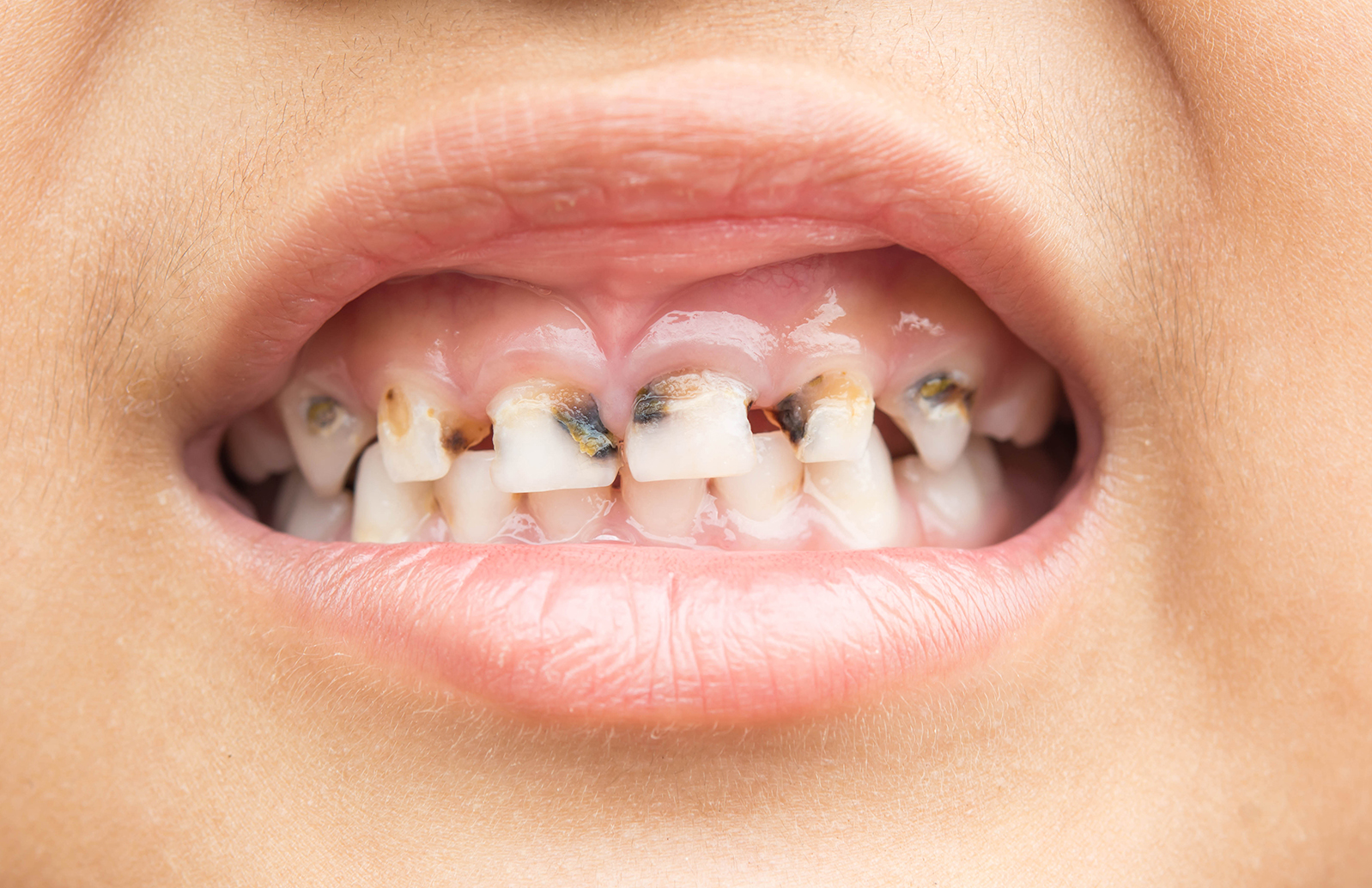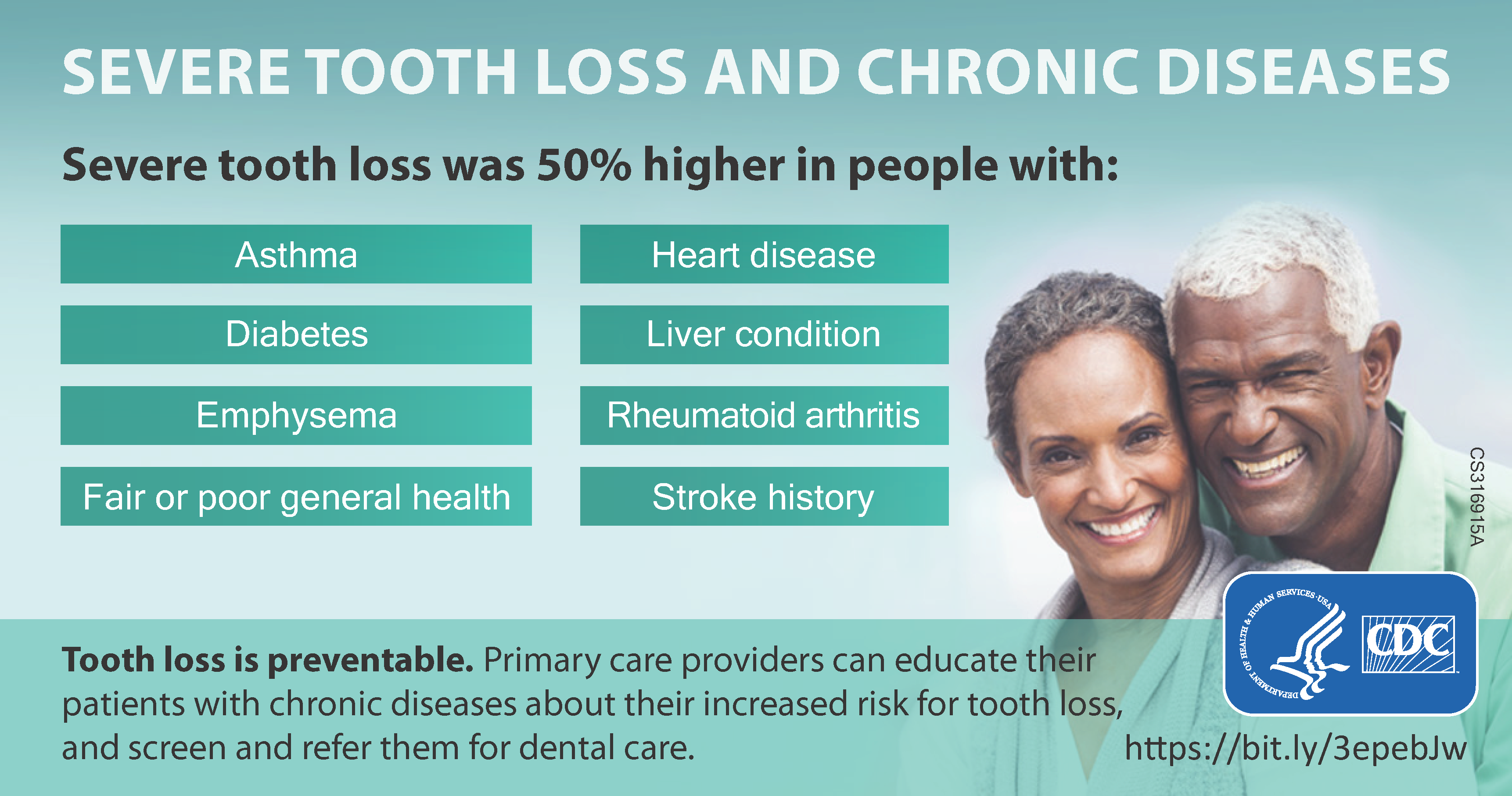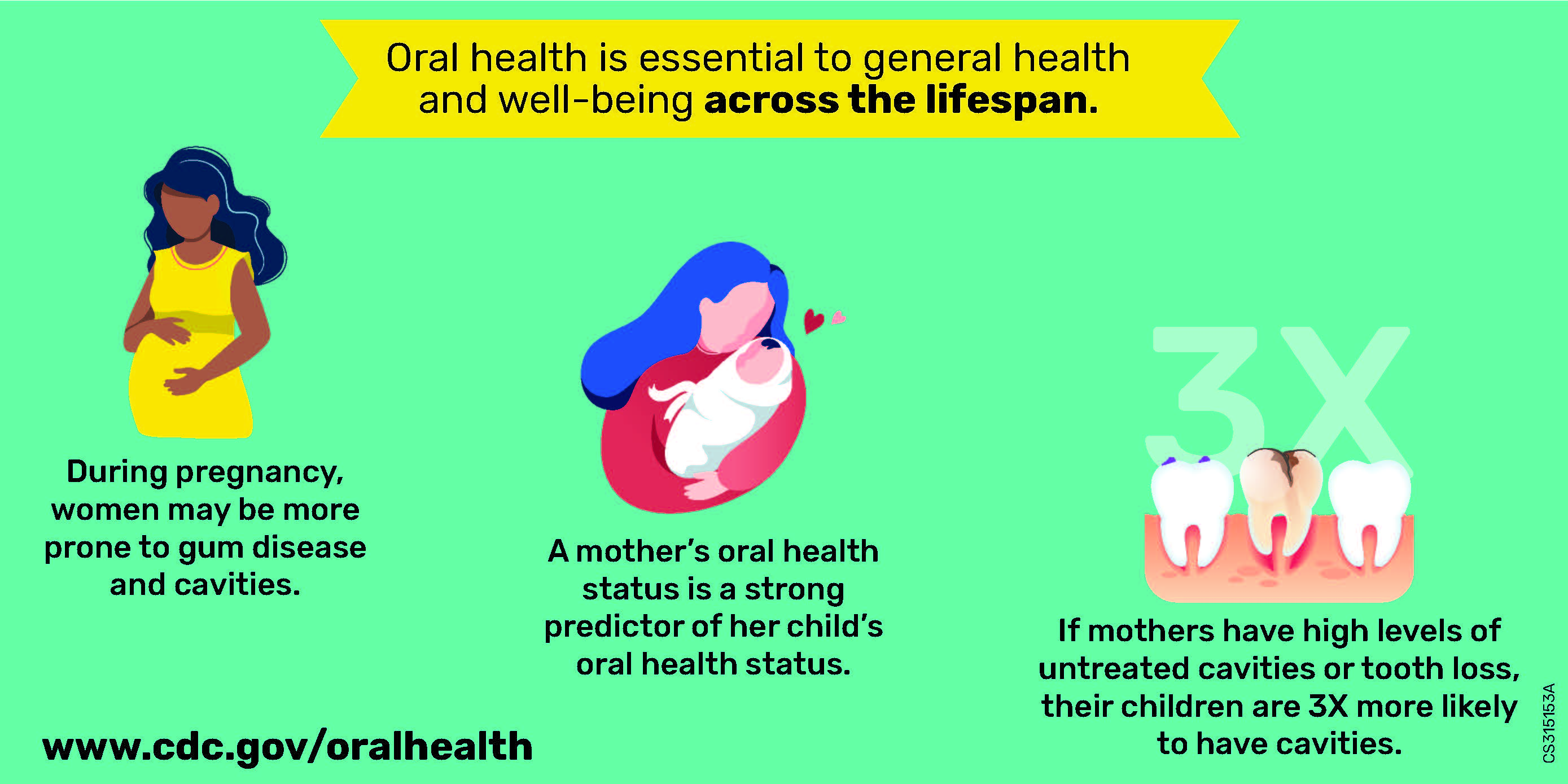Information for Professionals
“Oral health is essential to the general health and well-being of all Americans, and it is a window into the health of the body. Oral health can show signs of nutritional deficiencies or general infection, and diseases that affect the entire body can first become apparent because of oral problems.” Surgeon General Priority in 2020
Oral health is essential for general health and well-being of all Missourians. Oral health problems affect a person’s ability to eat and speak. Poor oral health is inter-connected with serious health issues like diabetes, heart disease, stroke and preterm or low birth weight just to name a few. The good news is that oral health problems are preventable. A healthy smile for life starts with healthy habits of brushing and flossing, using fluoride toothpaste, making smart food choices and eating habits, and visiting the dentist twice a yearly.
All professionals need to be concerned about the oral health of all Missourians. This website provides resources to improve oral health outside of the dentist office. The information on this webpage is to help you learn and education others on the benefits of good oral health. As a professional - healthcare provider, dental provider, teacher or anyone else, you have the potential to influence the oral health of Missourians.
Just because the title of the resource may suggest a link or document is for one profession does not mean that other professionals will not find the information helpful, i.e. Oral Health Guide for Caregivers of School Aged Children. This guide contains good information and pictures regarding possible dental emergencies that may be seen anywhere not just at school.
Missouri Oral Health Statistics
The table below shows how Missourians are impacted by poor oral health.
Missouri vs National Statistics from National Oral Health Surveillance System
| Indicator | Missouri | National | National Measure | Health People 2020 Objective |
|---|---|---|---|---|
| Percentage of Adults Who Have Visited a Dentist in the Last Year | 63.3% 2018 | 67.3% 2018 | Median, N=53 | N/A |
| Percentage of Adults Who Have Had Teeth Cleaned in the Last Year | 61.7% 2018 | 69.0% 2018 | Median, N=53 | N/A |
| Complete Tooth Loss Among Adults 65 and Older | 65 and Older: |
65 and Older: 13.5% 2018 | Median, N=53 | 65 to 74 year-olds: 21.6% |
| Loss of 6 or More Teeth Among Adults 65 and Older | 42.8% 2016 | 36.0% 2016 | Median, N=53 | N/A |
| Percent Served by Community Water Systems that Receive Fluoridated Water | 75.6% 2018 | 73.0% 2018 | National Percentage | 79.6% |
| Caries Experience Among Third Grade Students | 54.8% 2018-2019 | 50.5% 2015-2016 | National Percentage | 6 to 9 year-olds: 49% |
| Untreated Tooth Decay Among Third Grade Students | 28.5% 2018-2019 | 15.3% 2015-2016 | National Percentage | 6 to 9 year-olds: 25.9% |
| Dental Sealants Among Third Grade Students | 29.7% 2018-2019 | 42% 2011-2014 | Median, N=53 | 6 to 9 year-olds: 28.1% |
| Cancer of the Oral Cavity and Pharynx Incidence | 12.6 per 100,000 population 2016 | 11.7 per 100,000 population 2016 | Age-adjusted incidence rate | N/A |
Children and Adolescents Oral Health
- Brush, Book, Bed from the American Academy of Pediatrics for children ages 0-6
- Dental Sealants & Disease Prevention, ADA 2022
- Opioids and Children and Adolescents: Information for Oral Health Professionals
- Preventive Dental Visits for children and adolescents are important!
- Preventive Services Program (PSP) is dedicated to promoting and improving healthy smiles for all Missouri children through education and preventive services. The PSP is a community-based oral health program that relies on various volunteers in a community to achieve success. The PSP has a four-method approach: 1. Oral screenings, 2. Oral health education, 3. Fluoride varnish applications, 4. Referrals for unmet dental needs. The PSP home page shares more information on the program including testimonials and fluoride varnish application videos.
Oral Health Guide for Caregivers of School-Aged Children
Diabetes and Oral Health
- The Connection Between Oral Health and Diabetes
- Diabetes: Dental Tips | Spanish
- Diabetes and Dental Health
- Diabetes and oral health, a patient guide from American Dental Association
- American Diabetes Association
- Diabetes: symptoms and causes
- Diabetes and Oral Health from American Diabetes Association, Diabetes Advisor
Electronic Cigarette Use, Vaping and Oral Health
- Clearing the Air: The Relationship Between Electronic Cigarette Use, Vaping and Oral Health
- E-cigarette temperature may affect oral health by changing properties of inhaled aerosols
- Potential oral health effects of e-cigarettes and vaping: A review and case reports
- Harmful chemicals emitted from electronic cigarettes and potential deleterious effects in the oral cavity
The following links may be helpful for patients:
Fluoride and Oral Health
Fluoride for Strengthening Teeth
- Fluoride Fact Sheet for Health Professionals
- Fluoride Fact Sheet for Consumers
- Fluoride Use in Caries Prevention in the Primary Care Setting
- Water Fluoridation
- How to Read a Study about Fluoride or Fluoridation
- All About Fluoride
- Best Practices: Fluoride Therapy from the American Academy of Pediatric Dentistry (AAPD)
- Fluoride Use in Caries Prevention in the Primary Care Setting 12/2020 from the American Academy of Pediatrics
- Silver Diamine Fluoride Scientific Literature Review 2016
- Evidence-Based Dentistry Update on Silver Diamine Fluoride from HHS Public Access (NIH) 2020 Jan 01
- Topical Fluoride Varnish: Below is a listing of resources that will be helpful when implementing an oral health component and topical fluoride varnish in your medical practice.
- The MO HealthNet Dental Provider Manual Section 13.33 outlines information for medical profession regarding applying and billing for Topical Fluoride Varnish.
- Smiles for Life: A National Oral Health Curriculum is designed to enhance the role of primary care clinicians in the promotion of oral health. Physicians wishing to provide fluoride varnish in their practices must complete Course 6: Caries Risk Assessment, Fluoride Varnish and Counseling.
- OPEN WIDE Oral Health Training for Healthcare Professionals helps healthcare and early childhood professionals (for example, Head Start, home visiting, and WIC staff) working in community settings to promote oral health in the course of promoting general health for infants, children, and their families.
- The American Association of State and Territorial Dental Directors’ (ASTDD) Fluoride Varnish: an Evidence-Based Approach Research Brief provides supporting evidence for the implementation of fluoride varnish in your practice.
- The American Academy of Pediatrics (AAP) Oral Health Education and Training
- Healthychildren.org AAP provides resources for oral health education in your practice.
This image reflects large areas of active tooth decay in a child’s baby teeth. The areas of decay are most likely caused by the child being put to bed with a bottle at an earlier age; the term is called “Early Childhood Caries” or also called “Baby Bottle Tooth Decay.” Babies should never be put to bed with a bottle filled with any liquid, if a bottle is necessary at bedtime, tap water should be the only choice.

Medical and Oral Health Issues
- Americans Are Still Not Getting the Dental Care They Need
- Burning Mouth Syndrome
- Could the path to better brain health involve better mouth care?
- Detecting Oral Cancer, A Guide for Healthcare Professionals
- Head and Neck Cancer and HPV
- Inequity Along the Medical/Dental Divide, January 2022
- Integrating Oral Health into Primary Care
- The Link between Ventilator Pneumonia & the Mouth
- Medical-Dental Integration
- Missed Connections: Providers and Consumers Want More Medical-Dental Integration
- Recent Trends in Hospital Emergency Department Visits for Non-Traumatic Dental Conditions
- Understanding dental caries as a non-communicable disease
MHPPS - Health Professional Financial Incentive Program
Missouri Health Professional Placement Services (MHPPS) (https://www.mhpps.org)
(Guide to Health Professional Financial Incentive Programs)
Older Adults and Oral Health

- Best Practice Approach: Improving The Oral Health of Older Adults
- Finding Low-Cost Dental Care: Information for Caregivers | Spanish
- Locate Low-Cost Dental Services in Missouri
- Older Adults and Oral Health | Spanish
- Oral Health and Aging Brushing Guide | Spanish
- Oral Health and Aging Dry Mouth | Spanish
- Oral Health and Aging Flossing Guide | Spanish
- Prevalence of and Changes in Tooth Loss Among Adults Aged ≥50 Years with Selected Chronic Conditions
- Unique Challenges at the Interface Between Nutrition and Oral Health
- Total Tooth Loss and Chronic Disease
Oral Care for People with Developmental and/or Physical Disabilities
- Children with Special Health Care Needs: An Introduction to Practical Oral Care for People with Developmental Disabilities, the National Institute for Dental and Craniofacial Research (NIDCR) provides a series of publications, Practical Oral Care for People with Developmental Disabilities, equips dental professionals in the community with the basic information they need to deliver quality oral health care to people with special needs. In addition, NIDCR provides information on developmental disabilities and strategies for care. NIDCR provides two continuing education credits upon successful completion of a post-test, see the section ‘For Dental Professionals.’
- An Oral Health Professional’s Guide to Serving Young Children with Special Health Care Needs is a series of five self-contained online modules designed to provide oral health professionals with information to help ensure that young children with special health care needs have access to health promotion and disease prevention services that address their unique oral health needs in a comprehensive, family-centered, and community-based manner. This curriculum was developed by a multidisciplinary team of experts with funding from the Maternal and Child Health Bureau, Health Resources and Services Administration.
- Planning Guide for Dental Professionals Serving Children with Special Health Care Needs was developed by the University of Southern California University Affiliated Program, Children’s Hospital Los Angeles that helps oral health professionals better communicate and work with families to ensure that appropriate, quality oral health care is provided both at home and in the dental office.
- Management of Dental Patients with Special Health Care Needs
- Children and Adolescents with Special Health Care Needs
- Oral Health Services for Children and Adolescents with Special Health Care Needs—A Resource Guide Fourth Edition
- Oral Health Guidance for Dental Professions—Children with SHCN and Their Caregivers
Oral Health during Pregnancy
Percent of Pregnant Missouri Women Who Responded Regarding Their Oral Health, 2018*
| Question | Percent |
|---|---|
| Knew importance of dental care during pregnancy | 86.7% |
| Talked with dental or health care worker about oral care | 46.8% |
| Knew that insurance covered dental care | 78.5% |
| Needed to see dentist for a problem | 26.7% |
| Went to a dentist about a problem | 16.2% |
Reasons for Pregnant Missouri Women Not Going to the Dentist, 2018*
| Could not find dentist to take pregnant patients | 8.5% |
| Could not find a dentist who would accept Medicaid patients | 27.6% |
| Did not think it would be safe during pregnancy | 11.5% |
Percent of PRAMS Participants – Teeth Cleaned During Pregnancy*
| 2015 | 2016 | 2017 | |
|---|---|---|---|
| Missouri | 50.1% | 43.5% | 45.4% |
| Nationwide | 48.3% | 44.6% | 46.3% |
*Date for the three tables above sourced from CDC PRAMS Web Site
- Periodontitis and Adverse Pregnancy Outcomes – Placental colonization with periodontal pathogens: the potential missing link, published online 2019 Apr 30
- Relationship between Periodontal Diseases & Preterm Birth – Review Article 2011
- Fact Sheet – Guidance for Oral Health Professionals for Pregnant Women
- Fact Sheet – Guidance for Prenatal Care Health Professionals
- Pharmacological Considerations for Pregnant Women
- Perinatal Oral Health Policy Statement, Association of State & Territorial Dental Directors (ASTDD) 2020/2/25
- Infographic – Dental care is safe and important during pregnancy
- Oral Health During Pregnancy – Oral Health’s Unanswered Questions
The Children’s Dental Health Project launched Oral Health’s Unanswered Questions as a special series to take a fresh look at issues that the oral health community widely agrees are a priority but has struggled to address. These issue briefs and the questions they pose are intended to start a dialogue about strategies for improving the health and stability of families. - Preventive Dental Visits for pregnant women are important!
- Pregnancy and Dental Health

Oral Health Education
- The Office of Dental Health offers free materials regarding oral health at Oral Health Education
